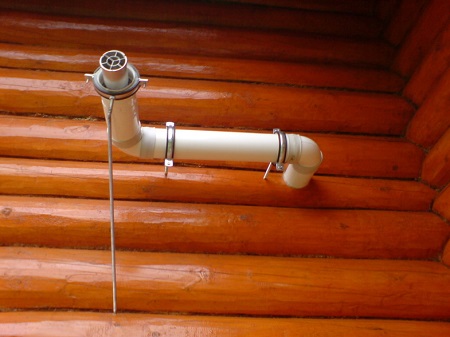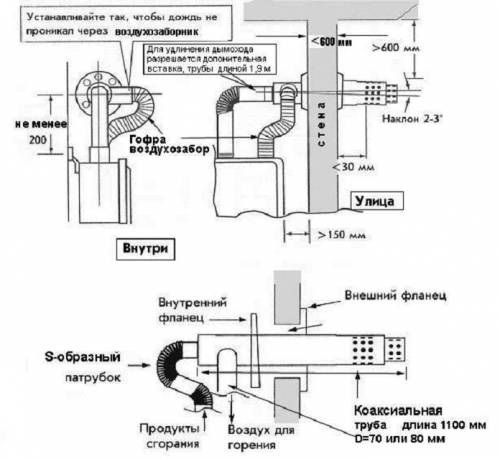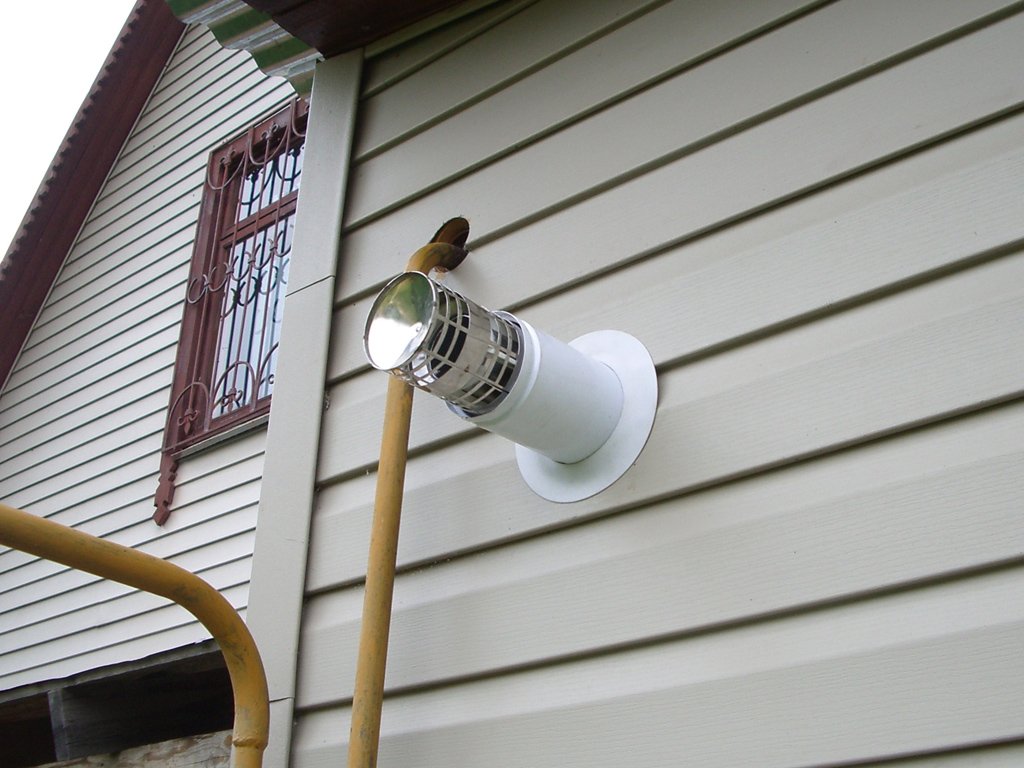Today, there are many systems that can solve the important issue of ventilation, that is, the compensation of the allocated low-quality (smoky) air with fresh (cold from the street). A variety of boilers equipped with forced draft and fan perform this desired function through a coaxial chimney.
Usually there are two types of coaxial chimneys:
- vertical chimney;
- horizontal chimney.
Coaxial chimneys are quite simple in their design. They have two pipes: for the passage of fresh air from the outside and for the removal of internal exhaust gases from the ventilated room.
Coaxial chimneys work according to a principle called “pipe in pipe”, in which case the oxygen necessary for burning fuel is supplied through the external pipe from the street, and combustion products are discharged through the internal pipe. This is a very convenient and reliable chimney design. At the same time, the entire system is sealed and reliably protected.
Such a simple coaxial chimney can be done with your own hands. To do this, you need to have patience and knowledge of several important installation rules to create fireplaces, stoves, chimneys.
Content
Coaxial Chimney Installation Requirements
Consider the basic rules that should be followed when performing installation work when installing chimneys:
- the design of gas supply systems that use natural gas as fuel must be carried out in accordance with the requirements of SNiP 2.04.08–87, as well as adhering to the “Safety Rules in the Gas Economy”;
- natural gas should be supplied by a gas pipeline with a working pressure of up to 0.03 kg / sq.cm (0.003 MPa);
- the gas pipeline is introduced directly into the room where the thermal units should be;
- chimney gases are discharged in accordance with the norms and rules of SNiP 2.04.05–91.3;
- smoke and gases can be removed through the outer wall from a heat generator equipped with an installation for their removal ..
Coaxial outdoor chimney, pros and cons

Outdoor chimneys have both their positive and negative properties and characteristics.
The positive indicators include the following:
- significant savings in the interior space of the room;
- lack of need to violate the integrity of the roof;
- for outdoor installation there are no spatial restrictions, which allows you to perform all the work easier and faster.
In addition to the pros, of course, there are also disadvantages of installing external chimneys:
- chimney insulation makes installation more expensive;
- sometimes interferes with the design perception of the entire construction complex, in general ;;
- the presence of horizontal sections during installation.
After weighing all the pros and cons, we decide the next question, how to install a coaxial outdoor chimney with your own hands.
Outdoor chimneyinstallation rules
- An external coaxial chimney can be installed if the building is already built and there is no heating in it. First, you must correctly determine the place for the heating system and for the entrance of the chimney pipe, and the installation of the apparatus for heating can be done later.
- Be sure to make markings on the outer wall to determine the exit to the mounted chimney. Follow the rules that make an outdoor chimney fireproof.
- Next, we install the coaxial chimney and make a hole of the desired size.

If the wall contains substances with low heat resistance, then to prevent the risk of fire, all the necessary places are isolated with special mineral-wool means.
- Carrying out all the internal work in the house, the external chimney is connected to the heating unit first by a sectional single-circuit elbow, and then with a double-circuit tee.
- A tee with a removable ramp is used in order to fix the chimney system in a vertical position. Then the chimney is securely fastened with special brackets to the wall.

Carefully check the calculations of all parameters so that the chimney passes through the roof integrally, without unnecessary joints.
Indoor Coaxial Chimney, Pros and Cons
Coaxial chimneys of the internal type, like the external chimney, have their own advantages and disadvantages.
Consider the main advantages of these chimneys:
- simplicity in installation;
- lack of additional foundation;
- vertical position of the chimney;
- excellent traction;
- ease of maintenance.
There are few shortcomings in internal chimneys, but still there are:
- uses part of the internal space;
- inconvenience when passing between floors;
- additional fire protection measures are needed.
Internal chimney installation requirements
- How to choose the right diameter of the chimney is usually indicated in the instructions that are attached to the passport. The main thing is that the diameter of the outlet of the heating device should not be wider than the diameter of the chimney.

Mounted Coaxial Chimney - Using a pipe, tee or elbow, the boiler is connected to the unit. At the same time, the links are attached by a chain: the next to the previous one (the lower links enter the upper ones, thereby not creating obstacles for the outgoing smoke).
- The installation of double-circuit pipes is carried out using a transitional unit, and the joints are fastened with other nodes very rigidly using clamps.
- At the outlet of the chimney, horizontal assembly is performed if the pipe is located on the side. It is much more convenient if it is at the top, it is easier to bring the chimney into a vertical position using various brackets.

Each heating device must have its own chimney, all the elements of which must fit very tightly together, entering up to half the diameter of the chimney.
- If during installation there is an obstacle (for example, a beam) that needs to be circumvented, then you need to select the right elbow in advance. To increase the deflection angle, use two elbows.
- The most dangerous stage of work is the passage of the roof. To protect against fire, special nozzles and non-combustible mineral material should be used to isolate the chimney and ceilings, while leaving an air gap.
- In premises, use special covers that will prevent the chimney from touching various objects in the house.
- Further, the chimney is discharged through the roof, while the outlet must be completely sealed, and with a special apron tightly close all joints.
Chimneys Schiedel Is the key to quality and reliability
The famous Schiedel company offers an excellent solution for organizing chimney systems. Schiedel Quadro chimneys developed by European experts are perfect for individual heating of apartment buildings, individual cottages, where there is no separate furnace room, and the boiler is most often installed in the kitchen. In the people, this design was called "Sidel chimney".
The main advantages that Schiedel chimneys have are the following:
- compact design dimensions;
- Durability of the chimney (up to 50 years or more);
- reliability and safety during operation;
- does not require the allocation of separate areas for the boiler room;
- excellent resistance to corrosion, moisture and aggressive environments.
In addition, owners of coaxial chimneys can optionally not install a ventilation system, which, of course, saves money and time for construction and installation.
Coaxial chimney is a guarantee of the productive work of the heating equipment connected to it, as well as a guarantee of a comfortable life for the owners of this chimney system.





Alas, no comments yet. Be the first!